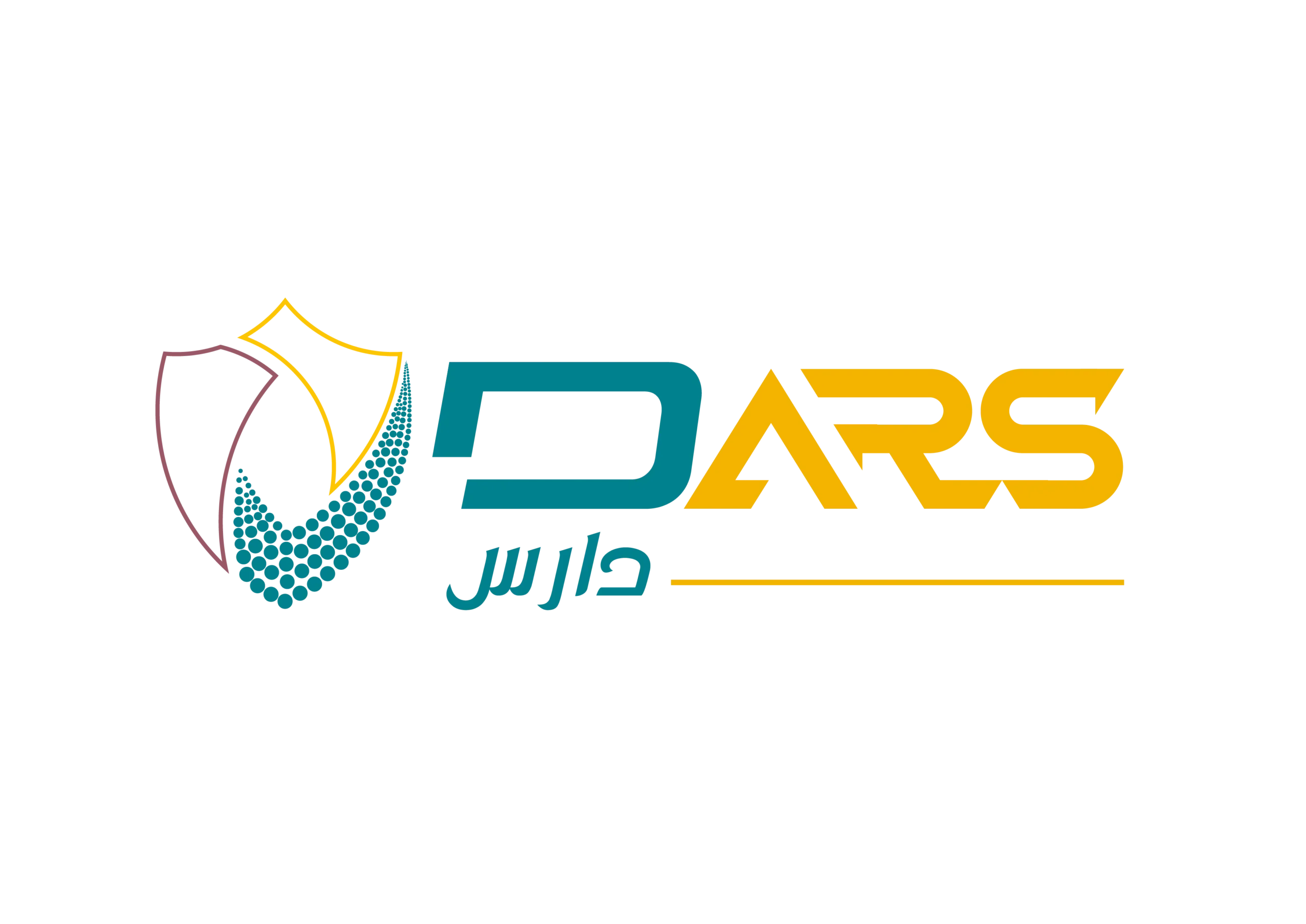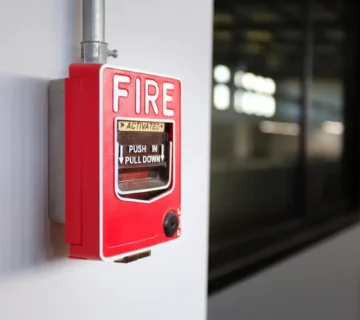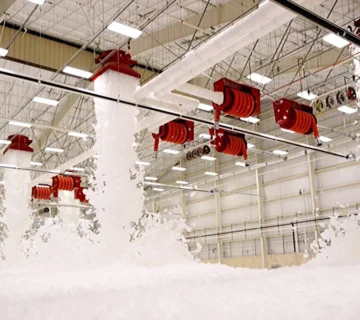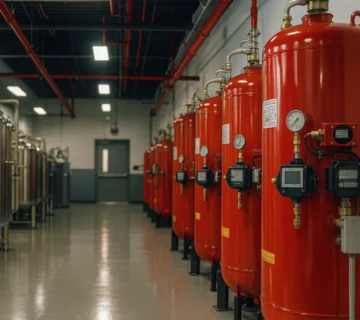Introduction
Understanding fire extinguisher types is more than a matter of compliance; it’s about ensuring the safety of lives, property, and businesses. In Saudi Arabia, where industrial and commercial developments are rapidly expanding, the importance of proper fire protection systems and portable fire extinguishers cannot be overstated. Every building, whether residential, industrial, or commercial, must follow strict safety regulations that align with the standards set by the Saudi Civil Defense and international frameworks such as the NFPA codes.
Selecting the right fire extinguisher for each environment is not merely a technical choice, it’s a strategic one. It determines how effectively a fire can be controlled in its initial stage, often making the difference between a minor incident and a major disaster. By understanding the various extinguisher types and their applications, organizations can meet building safety compliance standards while also safeguarding people and assets.
What Are the Different Classes of Fire and Corresponding Extinguishers?
To choose the right fire extinguisher, it’s essential to first understand the classes of fire, each defined by the nature of the fuel involved. Saudi Arabia follows the same international classification system recognized by NFPA and SASO standards.
- Class A: Fires involving ordinary combustibles like wood, cloth, and paper.
- Class B: Fires caused by flammable liquids such as gasoline, oil, or paint.
- Class C: Electrical fires originating from wiring, appliances, or equipment.
- Class D: Fires involving combustible metals such as magnesium or titanium.
- Class K: Fires caused by cooking oils and fats, often in restaurant kitchens.
Each fire type requires a specific extinguishing agent. For example, using water on an electrical fire (Class C) can worsen the situation, while CO₂ or dry chemical extinguishers are much safer. Understanding this correlation forms the foundation of emergency preparedness in any facility.
The right match between extinguisher type and fire class not only enhances effectiveness but also prevents re-ignition and secondary hazards. This knowledge is particularly crucial in high-risk environments like industrial zones or data centers in Saudi Arabia.
What Are the Common Types of Fire Extinguishers Used in Saudi Arabia?
Saudi Arabia’s commitment to fire safety equipment and regulatory enforcement has led to widespread adoption of advanced extinguisher technologies. Below are the most common types found across different environments, each designed for specific fire classes.
Water and Foam Fire Extinguishers
Water and foam extinguishers are primarily used for Class A fires involving paper, textiles, and wood. The water cools the burning material, while the foam cuts off the oxygen supply. This dual action effectively suppresses flames and prevents re-ignition.
These extinguishers are common in homes, offices, and low-risk areas where flammable liquids or electrical equipment are not a concern. They’re simple to use and among the most eco-friendly options available.
Carbon Dioxide (CO₂) Fire Extinguishers
CO₂ extinguishers are vital for environments with high electrical usage. Designed for Class B and C fires, they work by displacing oxygen and removing heat with a freezing discharge. Their major advantage lies in being residue-free, which means they don’t damage sensitive electronics or machinery.
They’re commonly installed in server rooms, data centers, and laboratories, where electrical hazards are prominent. However, they should be handled carefully due to their high-pressure discharge and cold nozzle, which can cause frostbite if misused.
Dry Chemical Powder Fire Extinguishers
These are among the most versatile fire suppression methods available. Effective against Classes A, B, and C, dry chemical powder extinguishers interrupt the chemical reaction within the fire triangle heat, fuel, and oxygen.
The powder used is typically monoammonium phosphate, which melts and coats the burning surface, cutting off oxygen. They’re widely used in factories, workshops, and fuel stations due to their broad applicability and quick action.
However, while highly effective, they can leave a residue that may require thorough cleanup, especially on electronic or mechanical equipment.
Wet Chemical Fire Extinguishers
Wet chemical extinguishers are designed specifically for Class K fires, making them indispensable in commercial kitchens. They contain a potassium-based agent that cools the fire and forms a soap-like layer, cutting off oxygen and preventing reignition.
Restaurants, catering facilities, and food manufacturing plants must install these extinguishers as part of workplace safety protocols. In Saudi Arabia, their installation is mandatory for all establishments handling large quantities of cooking oils.
How to Properly Select a Fire Extinguisher for Your Property in Saudi Arabia
Choosing the right fire extinguisher involves more than picking a random model from a catalog. It requires evaluating fire risks, building layout, and safety compliance requirements. The Saudi Civil Defense mandates that every facility conduct a fire risk assessment before installation.
The selection process depends on:
- Fire risk type: Identify whether the environment has combustible materials, electrical hazards, or flammable liquids.
- Regulatory standards: Ensure compliance with Saudi Civil Defense and SASO technical standards for capacity, signage, and placement.
- Professional guidance: Consult certified fire protection systems experts, such as DARS, to assess requirements and install approved equipment.
For residential buildings, compact portable fire extinguishers like CO₂ or water-based models are ideal. Commercial spaces require a mix of dry powder and CO₂ types, while industrial facilities often need a combination of foam and specialized agents for metal fires.
Proper selection not only ensures emergency preparedness but also helps meet safety regulations in Saudi Arabia, which are strictly enforced through regular inspections by civil defense authorities.
What Are Saudi Arabia’s Fire Extinguisher Regulations and Compliance Requirements?
Fire safety in Saudi Arabia is governed by a detailed regulatory framework developed by the Saudi Civil Defense and the Saudi Standards, Metrology and Quality Organization (SASO). These laws ensure that all fire equipment including extinguishers meets international safety standards and is properly installed and maintained.
According to the Technical Regulation for Fire Control Materials and Equipment, every building must:
- Install approved fire extinguishers according to risk classification.
- Display visible signage showing extinguisher types and locations.
- Conduct regular inspection and servicing by certified professionals.
The Saudi Building Code (SBC 801) also outlines detailed requirements for placement, maintenance, and periodic testing. Non-compliance can lead to penalties or operational shutdowns, especially for high-risk facilities such as manufacturing plants or hospitals.
The Saudi Civil Defense Department plays a crucial role in enforcing these regulations. It conducts safety audits and issues certificates of approval for compliant premises. Businesses must also conduct fire drills and provide training to employees on proper extinguisher use.
Why These Standards Matter
Regulatory compliance isn’t just about ticking boxes; it directly impacts a company’s reputation and operational continuity. In Saudi Arabia’s growing industrial and commercial landscape, ensuring building safety compliance reflects a company’s commitment to protecting its workforce and community.
Moreover, adherence to safety regulations in Saudi Arabia supports Vision 2030’s broader goals of sustainable industrial development and risk management. As industries expand, maintaining world-class fire protection systems becomes an essential part of responsible growth.
Best Practices for Placement and Accessibility of Fire Extinguishers
After selecting the right fire extinguisher types, the next essential step is ensuring their proper placement and accessibility. Even the most advanced extinguishers are useless if they’re hidden, blocked, or placed too far from potential fire hazards. In Saudi Arabia, where strict building safety compliance regulations apply, every placement decision must follow Civil Defense and SASO guidelines to ensure maximum safety coverage.
Fire extinguishers should be positioned along normal paths of travel, typically near exits or entrances, allowing occupants to access them quickly during emergencies. The general rule is that no person should have to travel more than 30 meters to reach an extinguisher. Height is another crucial factor extinguishers must be mounted so that the handle is easily reachable by any adult, including people with limited mobility. This principle ensures universal accessibility and promotes inclusivity in workplace safety planning.
A common mistake in many facilities is placing extinguishers behind doors or large equipment. This oversight delays emergency response, especially during panic situations. Instead, they should be mounted on visible, unobstructed walls, with clear signage in both Arabic and English. Regular employee training also plays an important role in helping individuals locate and use extinguishers efficiently during fire outbreaks.
Accessibility for Different Environments
In residential buildings, extinguishers should be located near kitchens, hallways, and exits. In corporate offices, placement near electrical rooms, storage areas, and high-traffic corridors is recommended. Industrial facilities, on the other hand, must position extinguishers close to production lines, chemical storage areas, and loading docks, where ignition risks are typically highest.
Special consideration must also be given to facilities serving the public, such as malls, hospitals, and educational institutions. Here, emergency preparedness requires both redundancy and visibility; multiple extinguishers placed within easy reach, coupled with illuminated safety signs. This arrangement reduces confusion and ensures quick access even when visibility is poor due to smoke.
In line with Saudi Civil Defense regulations, fire extinguishers should always be installed near designated emergency exits to guide occupants toward escape routes. These standards are not merely procedural; they save lives by ensuring that every second counts during a fire emergency.
How Often Should Fire Extinguishers Be Inspected and Maintained?
Routine inspection and maintenance of fire safety equipment are non-negotiable components of any fire protection strategy. Over time, extinguishers can lose pressure, become damaged, or even expire, making them unreliable when needed most. To prevent this, Saudi authorities have outlined clear requirements for testing and servicing in the Technical Regulation for Fire Control Materials and Equipment.
Every extinguisher must undergo a monthly visual inspection to confirm that it is accessible, fully charged, and free of damage or corrosion. Annual maintenance checks, performed by certified technicians, include detailed pressure testing, weight verification, and replacement of damaged components. A hydrostatic test should also be conducted every five years to ensure the cylinder can safely hold pressure. These inspections are typically logged on service tags attached to each extinguisher for record-keeping and verification during Civil Defense audits.
Neglecting maintenance not only jeopardizes safety but also violates safety regulations in Saudi Arabia, potentially resulting in fines or closure of non-compliant facilities. More importantly, it places occupants at unnecessary risk. A well-maintained extinguisher can prevent minor incidents from escalating into catastrophic fires, preserving both lives and property.
Documentation and Compliance
One of the most overlooked yet critical aspects of fire protection systems is documentation. Every inspection, refill, and test must be properly recorded and retained for verification by authorities. The Saudi Civil Defense may request these records at any time during audits or investigations following an incident. Maintaining transparent documentation not only demonstrates accountability but also builds confidence among tenants, employees, and regulatory bodies.
For commercial and industrial sites, maintaining detailed inspection logs ensures compliance with the Saudi Building Code (SBC 801). It also facilitates smoother insurance claims in the event of a fire. Many insurers require proof of regular maintenance as part of their coverage conditions. Companies that neglect these records risk voiding their fire insurance policies altogether.
In addition to physical logs, many organizations are now adopting digital monitoring systems that automatically track service intervals and alert management when inspections are due. These innovations are part of a larger movement toward smart safety management, an approach that blends compliance with technology for efficiency and reliability.
The Role of Professional Fire Safety Services
While basic maintenance tasks can be performed internally, complex inspections and testing should always be handled by certified professionals. Companies like DARS specialize in delivering end-to-end fire safety solutions that adhere to Civil Defense standards. Their expertise ensures that extinguishers are not only installed correctly but also maintained and replaced in accordance with national codes.
Professional service providers also assist in risk assessment, helping organizations determine the most suitable fire suppression methods for their unique environments. From selecting extinguisher capacities to designing evacuation routes, their guidance streamlines compliance and reduces operational risks. Moreover, such partnerships contribute to building a safety culture within organizations, reinforcing the importance of preparedness and vigilance.
Common Mistakes in Fire Extinguisher Management
Despite strong regulatory oversight, certain recurring mistakes continue to undermine fire safety efforts in Saudi Arabia. One common issue is neglecting expired extinguishers. Every unit has a specific lifespan typically between 5 to 15 years after which the chemical agents lose effectiveness. Using outdated extinguishers can lead to failed discharges during emergencies.
Another frequent problem is improper signage. Even when extinguishers are correctly placed, lack of clear labeling causes confusion during panic situations. Facilities should ensure that all extinguisher locations are clearly marked with reflective signs that remain visible even in low light or smoky environments.
Improper staff training is another critical weakness. Employees must be regularly trained on how to identify different fire extinguisher types and operate them safely. Using the wrong extinguisher, such as a water-based one on an electrical fire, can have dangerous consequences. Regular drills and refresher sessions are therefore essential for sustaining readiness.
Integrating Fire Extinguishers into Broader Fire Protection Systems
A single extinguisher cannot guarantee safety on its own. It must function as part of a larger, interconnected network of fire protection systems, including alarms, sprinklers, and smoke detectors. When integrated effectively, these systems form a comprehensive defense mechanism that minimizes damage and maximizes response efficiency.
In Saudi Arabia, building designs increasingly incorporate automated systems that detect heat and smoke, triggering alerts while also activating suppression devices. Manual extinguishers complement these technologies by providing first-response tools until professional firefighters arrive. This hybrid approach aligns with modern emergency preparedness strategies, ensuring that every layer of protection is covered.
The Importance of Continuous Improvement
Fire safety is not a static process it evolves with technology, regulation, and awareness. As new extinguishing agents and smart monitoring tools become available, businesses must stay informed and adapt accordingly. The most resilient organizations in Saudi Arabia are those that treat fire safety as an ongoing commitment rather than a one-time installation.
Continuous improvement also extends to culture. Employees should be encouraged to report hazards, participate in drills, and engage with safety initiatives. This proactive approach transforms fire safety from a legal requirement into a shared organizational value, fostering trust and responsibility across every level.
Emerging Trends and Innovations in Fire Extinguishers in Saudi Arabia
Fire safety in Saudi Arabia is entering a new era of modernization driven by technology, environmental awareness, and regulatory advancement. Traditional extinguishers are being replaced or upgraded with smarter, greener, and more efficient systems that align with Vision 2030’s sustainability and safety objectives. These changes are not only improving the effectiveness of fire control but also making maintenance easier and more reliable across residential, commercial, and industrial sectors.
One of the most promising trends is the introduction of eco-friendly extinguishing agents. Older chemical-based foams are gradually being phased out due to environmental concerns. Newer compounds, such as water-mist and clean-agent systems, minimize toxic residue and are safe for both users and the environment. These systems meet international environmental standards while complying with the Saudi Standards, Metrology and Quality Organization (SASO) requirements.
Another notable advancement lies in smart fire extinguishers that come equipped with IoT-enabled sensors. These devices automatically report pressure levels, expiration dates, and maintenance schedules to a central dashboard. By integrating real-time monitoring, facility managers can ensure that every extinguisher remains fully functional, eliminating the risks associated with human oversight. This is particularly vital in large-scale facilities such as airports, factories, and hospitals, where downtime or inaccessibility could lead to severe consequences.
Sustainability and Environmental Responsibility
In line with global trends, Saudi Arabia’s fire protection systems are embracing sustainability as a key operational principle. Modern extinguishers are now designed with recyclable materials, refillable cylinders, and biodegradable extinguishing agents. This shift supports the Kingdom’s broader environmental initiatives while maintaining strict building safety compliance standards.
The Saudi Building Code (SBC 801) encourages the use of sustainable materials and energy-efficient safety devices in new construction projects. For companies, adopting these eco-conscious systems not only fulfills legal obligations but also enhances their corporate reputation. Clients, investors, and employees increasingly value businesses that take proactive measures toward reducing environmental impact.
At the same time, the transition to sustainable extinguishing solutions reduces waste and long-term operational costs. Refillable and modular systems, for instance, can be serviced locally, supporting Saudi Arabia’s growing fire safety industry while reducing reliance on imported equipment.
The Connection Between Fire Safety and Vision 2030
Saudi Arabia’s Vision 2030 framework emphasizes safety, sustainability, and innovation as pillars of national development. Fire safety equipment, including extinguishers, plays a direct role in achieving these goals by ensuring that industrial expansion happens responsibly. As the nation continues to build smart cities, mega-projects, and industrial zones, integrating advanced fire suppression methods becomes an operational necessity rather than an afterthought.
This strategic alignment between safety and development fosters investor confidence and supports the growth of key sectors such as construction, oil and gas, and hospitality. Fire safety compliance is now viewed as a marker of operational excellence. Businesses that maintain strong safety standards are more likely to attract international partnerships and secure project approvals.
Organizations like DARS are at the forefront of supporting Vision 2030 by implementing world-class fire protection systems. Through expert consultation, certified installation, and ongoing maintenance, DARS ensures that facilities across the Kingdom not only meet but exceed civil defense expectations.
The Role of Education and Awareness
Technological innovation alone cannot guarantee safety without awareness and education. Continuous training remains one of the most effective ways to strengthen emergency preparedness. Employees should know which extinguisher to use for each fire type, how to operate it correctly, and when to evacuate. These skills can significantly reduce casualties and property damage during emergencies.
Fire safety education also extends beyond workplaces. Homeowners, students, and community members must be encouraged to learn basic fire prevention tips, such as keeping extinguishers accessible, avoiding overloading electrical sockets, and maintaining kitchen ventilation systems. Such initiatives build a safety-conscious culture that complements national efforts toward risk reduction.
To support this awareness, many Saudi institutions now organize regular fire safety workshops and community programs in partnership with the Saudi Civil Defense Department. These initiatives not only improve public understanding but also create accountability among citizens and property owners.
Challenges in Implementation
Despite advancements, several challenges remain in ensuring consistent compliance across the Kingdom. One issue is the uneven enforcement of inspection schedules, especially in smaller establishments and residential complexes. Some property owners neglect regular servicing due to perceived costs or lack of awareness, not realizing that delayed maintenance can lead to system failures during emergencies.
Additionally, counterfeit extinguishers and uncertified suppliers pose risks to both safety and compliance. To combat this, the Saudi Civil Defense has intensified market surveillance, ensuring that only SASO-approved equipment is imported or sold within the Kingdom. Public-private collaboration remains essential to address these gaps effectively.
Another challenge involves updating older buildings that were constructed before modern safety standards were introduced. Retrofitting such facilities requires strategic planning, expert consultation, and adherence to new codes without disrupting daily operations. Companies like DARS play a vital role here, offering tailored solutions to upgrade aging infrastructure in line with current safety regulations in Saudi Arabia.
The Future of Fire Safety in Saudi Arabia
The future of fire safety in Saudi Arabia is shaped by a blend of smart technology, strict enforcement, and growing public responsibility. The continued adoption of digital monitoring, AI-based risk prediction, and automated suppression systems will revolutionize how fire protection is managed. These innovations promise faster response times, reduced operational risks, and better integration between private safety systems and government emergency services.
As industries evolve, so too must fire safety strategies. Continuous research and collaboration between government agencies, safety contractors, and technology providers will ensure that Saudi Arabia remains a leader in regional fire safety innovation. Beyond compliance, the national goal is to cultivate resilience creating communities, workplaces, and cities that can withstand and recover quickly from fire-related incidents.
Conclusion
Understanding fire extinguisher types is more than a technical requirement; it’s an essential part of protecting lives and sustaining growth. From Class A to Class K, each extinguisher serves a unique purpose in preventing disasters before they escalate. The Saudi Civil Defense and SASO have established a robust framework ensuring that all facilities, from homes to industrial complexes, remain equipped with certified, well-maintained extinguishers as part of comprehensive fire protection systems.
Compliance with building safety regulations in Saudi Arabia is not merely about avoiding penalties, it’s about preserving human life, assets, and trust. By embracing modern technology, sustainable materials, and professional guidance from trusted partners like DARS, businesses can create safer environments while contributing to Vision 2030’s mission of a secure and resilient Saudi Arabia.




